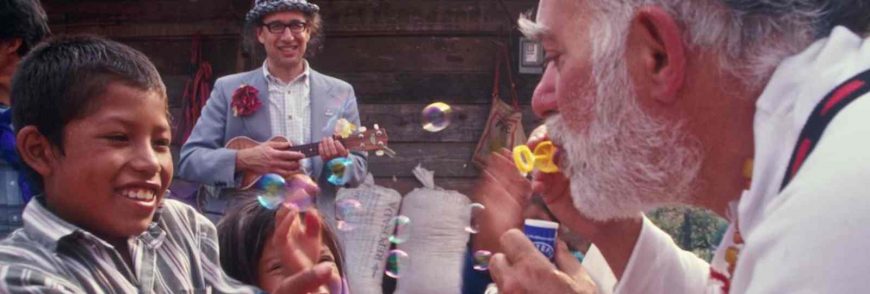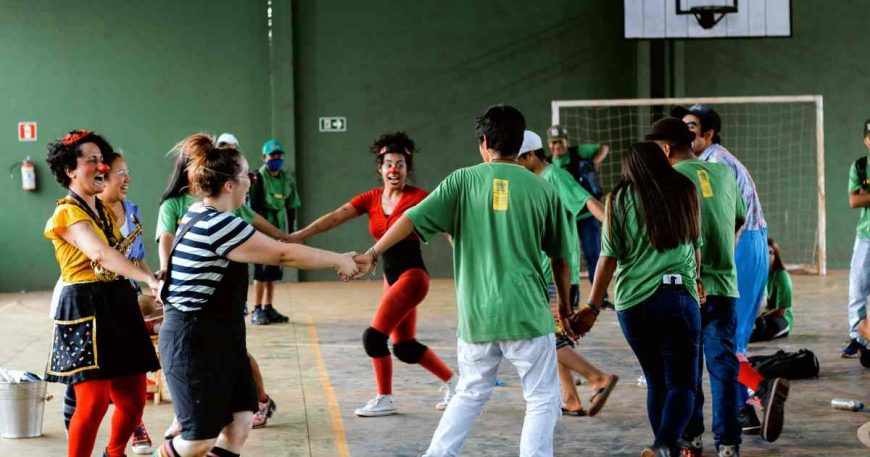Gear up for good! Shop our new collection of CWB apparel.

3 Ways to Foster Optimism and Support Kids’ Right to Play
If you compare your play life to that of a clown, you might suddenly feel fun-deficient.
But is it true?
What about all the ways you do play? Like cutting a unique life path, cooking without a recipe, or swapping silly jokes with a special kid in your life.
This last post in a series of three on ‘right to play’ will first remind you of your inherent playfulness. With this new outlook, you’ll be well-positioned to take action and become a Right to Play Champion. I’ll share three ways to do just that.
Grab your play passport and let’s roll!
Knowing Yourself as a Homo Luden

Have you ever seen a baby engage in non-verbal teasing?
Psychology researcher Vasudevi Reddy teamed up with parents to document several instances of babies acting like clowns. 🍼🤡
He studied infants, aged 7 – 11 months old, who would do things like offer a toy and then withdraw their offer, or pretend they were going to do something prohibited. In each instance, the baby would smile at their caretaker, watching for their response.
If the baby got a laugh, they’d repeat the action.
What’s going on here?
Turns out play is a big part of what makes us human. And that’s exactly what Dutch historian Johan Huizinga asserted in his 1938 classic book, Homo Ludens.

You love to laugh — and you know how much laughter has helped you through difficult moments.
You can give the gift of laughter to a child in crisis every month with a donation of just $11 monthly.
“There is a third function, however, applicable to both human and animal life, and just as important as reasoning and making — namely, playing.
It seems to me that next to Homo Faber [Human the Maker], and perhaps on the same level as Homo Sapiens [Human the Wise], Homo Ludens, Man the Player, deserves a place in our nomenclature.“
Johan Huizinga, Homo Ludens: A Study of the Play Element in Culture (1938)
Embracing a Play-Abundance Mindset

It’s one thing to know that you’re an inherently playful being. But it’s a whole other thing to practice play and believe you have enough energy and resources to play.
We call that a play-abundance mindset.
Operating from a play-abundance mindset cultivates joy and optimism and enhances your ability to
- Enjoy your humor
- Engage others in play
- Create original work
- _______________ (What else might be possible??)
Do you like the idea of play-abundance but feel more play-scarce? Tip the scale by hopping into the next section.
Three Ways You Can Support Kids’ Right to Play
1. Throw Your Hands In The Air If You’re a True Player

Thanks to the amazing educators at Playmaker Project, Clowns Without Borders (CWB) knows that kids’ ability to play is linked to how adults value play. To illustrate this connection, Playmaker likes to quote jazz musician Charlie Parker.
If you do not live it, it will not come out of your horn.
Charlie ‘Bird’ Parker
To help you step into a play-full life and a play-abundant mindset, I’ve made a list of play-related qualities (clown-inspired!) you can incorporate into your life in an ongoing, iterative way.
- Exploring ideas you wouldn’t have explored before
- Being curious
- Smiling first
- Taking the next step even when you don’t know what will happen
- Trying something new
- Saying yes to exciting things
- Admitting failure or mistakes
- Avoiding universal pursuit of perfectionism
Practicing these will help you see yourself as the Homo Luden you truly are. Pick one and, later, share in the blog comments about how it’s going!

Do you want laughter updates from around the world?
We’ll send them directly to your inbox.
Join the CWB fam.
Now let’s talk about how you can build opportunities for play in your neighborhood.
2. Stand for Kids’ Right to Play In the Place Where You Live

To lift play where you are, you’ll want to join forces with people who are doing the work.
If you’re not connected, you’re not alone.
A May 2023 advisory by the office of the US Surgeon General reported that, in the last 20 years, in-person social interaction has decreased across all age groups.
Connection is the solution, and the report lays out a National Strategy for how to make that happen. The framework includes six actions. We’ll focus on the first: Strengthen Social Infrastructure and Local Communities.

Social infrastructure (as defined in the report) is:
“the programs (such as those provided by volunteer organizations, sports groups, religious groups, and member associations), policies (like public transportation, housing, and education policies), and physical elements of a community (such as libraries, parks, green spaces, and playgrounds) that support the development of social connection.”
The bold-text items (my emphasis) represent tangible paths to get involved in your area, so many of which impact children and their right to play.
The greatness of a community is most accurately measured by the compassionate actions of its members, a heart of grace, and a soul generated by love.
Coretta Scott King
What if you want to support kids’ right to play around the world?
It’s storytime.
3. It’s Easy If You Try: Imagine the ‘Right to Play’ for All Kids

CWB sends artists to places of crisis where people are experiencing displacement. Children and families attend a show, and something magical happens.
This story, written by Tamara Palmer in a 2017 CWB blog post, explains the magic.
CWB-USA and CWB-South Africa ran a huge three-month tour of refugee camps and local villages in South Africa back in 2005. SOS Children’s Village was our primary partner. The clown troupe spent their time performing shows and held informal skill-building workshops. We returned the following year to continue our work with SOS.
Everywhere our artists went, the kids repeated the acts the clowns had performed for them the year prior!
The kids, captivated by the shows, had absorbed what they saw and did during their time spent with the clowns, and then replayed it.
Tamara continues:
Long-term mechanisms for relief exist in playfulness. This phenomenon has happened in other country locations across the globe. It is an indicator of the positive impact of our mission.
Clowns Without Borders artists use humor to alleviate the dreadful suspense of hardship. Children watch a show, interact with the clowns, and then continue to mimic the antics after the show finishes.
The need for humor and laughter is real. For us, it’s the best way we can help the world, especially those in suffering.
Clowns Without Borders comes for play. We deliver that play in ways other aid organizations aren’t equipped for.
You can bring play to a child today by joining us. Just $11 can change a single child’s life forever as they find themselves at their first clown show.
Conclusion
In what new way will you defend kids’ right to play?
Please leave us a comment and let us know your plans or share, with this supportive community, how your play life is coming along!
Music Match-up Game:
Did you catch any musical references in the subheadings?
(Answers: 1. Big Poppa/The Notorious B.I.G., 2. Stand/R.E.M., 3. Imagine/John Lennon)




Another great blog post Maggie! I consider babies “Clowns in training”. They definitely develop that sense of play and laughter early on. As a pediatric nurse, I have seen it as young as 6 or 7 months. To follow up on your previous post… yes, the connection of play and brain development is less commonly known. I think it is a really important aspect to educate people on! Playing helps children problem solve during a “game” which helps them to learn how to problem solve better during crisis or “real” life. Again, Thank you for all this info, education and fun! Keep playing on!
Thank you, Chip! Thank you for sharing your first-hand experience in seeing babies act like clowns. That is really valuable. Have a playful day!